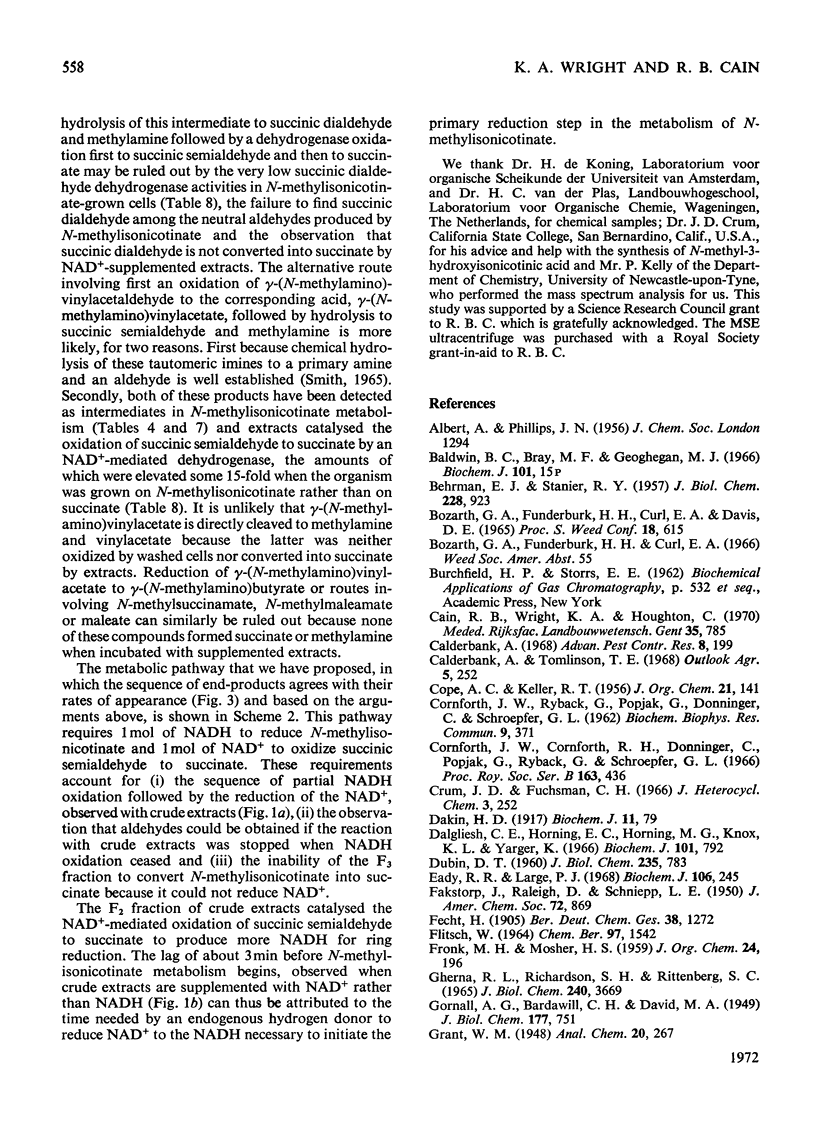Abstract
1. A bacterium, Achromobacter D, isolated from garden soil by elective culture, utilized N-methylisonicotinic acid (4-carboxy-1-methylpyridinium chloride) as sole carbon source. 2. Extracts of N-methylisonicotinate-grown cells oxidized this substrate only after supplementation with a source of nicotinamide nucleotides and then consumed 1 mol of O2 and released 1 mol of CO2/mol of N-methylisonicotinate supplied. 3. The N-methyl group of the substrate was released as methylamine whereas the five C atoms of the pyridine ring were accounted for as succinate and formate. The CO2 evolved by extracts was believed to derive from the carboxyl group on C-4 of the heterocyclic ring. 4. The immediate precursor of the succinate end-product was succinic semialdehyde; the inducible nature of succinic semialdehyde dehydrogenase in N-methylisonicotinate-grown cells supported this finding. 5. There was no evidence for monohydroxylation of the ring, but the time sequence of the appearance of the end-products indicated that the oxygen-requiring, NADH-requiring and decarboxylation steps clearly preceded the formation of methylamine and succinate. 6. The results are consistent with the oxidative cleavage of a partially reduced heterocyclic ring followed by several hydrolytic and dehydrogenase steps resulting in the appearance of the end-products.
Full text
PDF
















Selected References
These references are in PubMed. This may not be the complete list of references from this article.
- BEHRMAN E. J., STANIER R. Y. The bacterial oxidation of nicotinic acid. J Biol Chem. 1957 Oct;228(2):923–945. [PubMed] [Google Scholar]
- CORNFORTH J. W., RYBACK G. Stereochemistry of enzymic hydrogen transfer to pyridine nucleotides. Biochem Biophys Res Commun. 1962 Nov 27;9:371–375. doi: 10.1016/0006-291x(62)90018-9. [DOI] [PubMed] [Google Scholar]
- DUBIN D. T. The assay and characterization of amines by 2,4-dinitrofluorobenzene. J Biol Chem. 1960 Mar;235:783–786. [PubMed] [Google Scholar]
- Dakin H. D. On the Oxidation of Amino-acids and of related substances with chloramine-T. Biochem J. 1917 Aug;11(2):79–95. doi: 10.1042/bj0110079. [DOI] [PMC free article] [PubMed] [Google Scholar]
- Dalgliesh C. E., Horning E. C., Horning M. G., Knox K. L., Yarger K. A gas-liquid-chromatographic procedure for separating a wide range of metabolites occuring in urine or tissue extracts. Biochem J. 1966 Dec;101(3):792–810. doi: 10.1042/bj1010792. [DOI] [PMC free article] [PubMed] [Google Scholar]
- Eady R. R., Large P. J. Purification and properties of an amine dehydrogenase from Pseudomonas AM1 and its role in growth on methylamine. Biochem J. 1968 Jan;106(1):245–255. doi: 10.1042/bj1060245. [DOI] [PMC free article] [PubMed] [Google Scholar]
- Gherna R. L., Richardson S. H., Rittenberg S. C. The bacterial oxidation of nicotine. VI. The metabolism of 2,6-dihydroxypseudooxynicotine. J Biol Chem. 1965 Sep;240(9):3669–3674. [PubMed] [Google Scholar]
- Holcenberg J. S., Stadtman E. R. Nicotinic acid metabolism. 3. Purification and properties of a nicotinic acid hydroxylase. J Biol Chem. 1969 Mar 10;244(5):1194–1203. [PubMed] [Google Scholar]
- NASH T. The colorimetric estimation of formaldehyde by means of the Hantzsch reaction. Biochem J. 1953 Oct;55(3):416–421. doi: 10.1042/bj0550416. [DOI] [PMC free article] [PubMed] [Google Scholar]
- Sparrow L. G., Ho P. P., Sundaram T. K., Zach D., Nyns E. J., Snell E. E. The bacterial oxidation of vitamin B6. VII. Purification, properties, and mechanism of action of an oxygenase which cleaves the 3-hydroxypyridine ring. J Biol Chem. 1969 May 25;244(10):2590–2600. [PubMed] [Google Scholar]
- Wright K. A., Cain R. B. Microbial metabolism of pyridinium compounds. Radioisotope studies of the metabolic fat of 4-carboxy-1-methylpyridinium chloride. Biochem J. 1972 Jul;128(3):561–568. doi: 10.1042/bj1280561. [DOI] [PMC free article] [PubMed] [Google Scholar]


